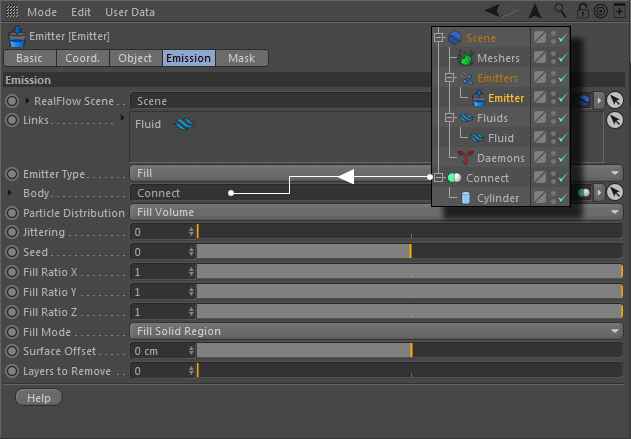Filling Objects Troubleshooting
Cinema 4D Primitives
Some of Cinema 4D's object types appearently refuse to be filled with particles, for example the native cylinder, oil tank, or tube primitives. The reason lies in the way how Cinema 4D treats these objects internally and let us demonstrate this with the help of a cylinder:
- Create a standard Cinema 4D cylinder and make it editable.
- Switch to "Points" mode, select the caps' vertices, and drag them apart.
As shown in the image the caps can be moved separately. This means that they are not connected with the rest of the cylinder, and RealFlow | Cinema 4D treats the cylinder as an open object that cannot be filled!
So the cylinder's parts have to be connected and the easiest way to do this is to parent the body under a "Connect" object:
- If you want to keep the cylinder's parametric state you have to drag the "Connect" object the → "Fill" emitter's Emission > Body field in order to fill it with particles.
- Alternatively it is also possible to make the connect-cylinder group editable.
- Another method is to activate the cylinder's "Fillet" option.Then set "Segments" to 1, and "Radius" to 0.001.
Using a connected parametric object with the "Fill" emitter.
Is the Object Closed?
Only completely closed objects can be filled. If an object is open somewhere - even if it is just a single polygon - it is no longer possible to differentiate between inside and outside and treats the object as a single-sided shell. In plain and simple words: you cannot fill polygons. Only objects with a volume can be filled, and this requires that their geometry is closed.
Another situation, where objects are not closed, is when parts are not connected as described under "Cinema 4D Primitives" above. These objects appear to be closed, but in fact they conisist of several objects and somevertices only share the same positions, but in fact they are not connected. In this case it is necessary to connect the vertices, e.g. with the help of a "Connect" object (see above).
Do I need a "Volume" tag?
By default a → "Volume" tag is not required if you want to fill a closed object, but it might happen that the fluid volume does not follow the object's outlines completely. There might be rounded corners or you see a gab between the particles and the object's surface. The reason for these effects is that RealFlow | Cinema 4D creates an internal representation of the object meant to be filled - the so-called collision geometry.
The collision geometry is created from standard values, and sometimes these default settings are not accurate enough. In this case it is necessary to apply a → "Volume" tag and decrease the "Cell Size" parameter or set "Collision Geometry Detail" to "High", for example. Another way to improve the result of the filling process is to use a sufficient amount of particles and increase the fluid container's → "Resolution".
Do I need a "Collider" tag?
A → "Collider" is not necessary if you want to fill the object only. But if the object should interact with the fluid then you have to apply this tag, because otherwise RealFlow | Cinema 4D wil only use the object as a template to create the particles:
- Filling only, no fluid-object interaction → no "Collider" tag required.
- Filling and fluid-object interaction → "Collider" tag required.
- Using an object as a → mask to delete particles → "Collider" tag required.

